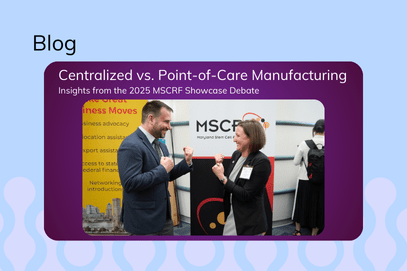dPCR vs. ddPCR: Why Precision Matters in Cell and Gene Therapy
by Rashmi Dubey, Ph.D., Senior Analytical Development Scientist, RoslinCT
dPCR vs. ddPCR: Why Precision Matters in Cell and Gene Therapy
In the rapidly evolving field of advanced therapies, precision in molecular quantification is critical. As a CDMO specializing in the development and manufacturing of cell and gene therapies, RoslinCT routinely evaluates and deploys robust analytical platforms to ensure accuracy, consistency, and compliance in the analytical testing of cell-based medicines. Among these tools, digital PCR (dPCR) systems such as Applied Biosystems’ AbsoluteQ (QuantStudio Absolute Q Digital PCR System | Thermo Fisher Scientific – US) and QIAGEN’s QIAcuity (QIAcuityDx Digital PCR System | QIAGEN), and the more widely adopted digital droplet PCR (ddPCR) systems such as BioRad’s QX200/QX600 (https://www.bio-rad.com/sites/default/files/2024-06/Bulletin_3600.pdf) and the most recent addition QX700 (https://www.bio-rad.com/sites/default/files/2025-07/Bulletin_3826.pdf), have emerged as pivotal technologies in quantifying nucleic acids with absolute precision.
But how do these two platforms (dPCR and ddPCR) compare, and which offers the greatest utility for cell therapy development and GMP manufacturing?
Understanding the Fundamentals
Digital PCR (dPCR) is a third-generation PCR technique that enables absolute quantification of DNA or RNA molecules without the need for standard curves. It operates by partitioning a sample into thousands of individual reactions, each acting as a binary event—either positive or negative for the target nucleic acid. The exact concentration of the target nucleic acid is then statistically calculated via the Poisson distribution.
ddPCR vs. dPCR: Key Comparisons in the CDMO Context
In general, dPCR and ddPCR instruments have equivalent capabilities (see Table 1), with ddPCR having more high-throughput options in a research environment and dPCR being fully integrated and automatic equipment highly suited for QC workflow and release assays. The key difference between these technologies lies in how they partition the sample:
- Droplet Digital PCR (ddPCR): Employs a water-oil emulsion to create approximately 20,000 (or more) nanolitre-sized droplets for sampling
- Chip-Based dPCR: Distributes the sample across a plate containing approximately 20,000 fixed micro-wells (AbsoluteQ) or nanoplate (QIAcuity).
We at RoslinCT have both Absolute Q and QIAcuity One 5 plex systems at the US and UK sites, respectively. In our experience, they can be used for key Cell Therapy molecular release assays interchangeably with minor modifications in workflow.
The Convenience Factor at CDMO: Why dPCR Shines in QC Release Assays
The ddPCR application is useful for the characterization of cells during process development activities in cell therapy. However, for critical QC release assays in cell and gene therapy manufacturing, factors such as convenience, robustness, and streamlined workflows are paramount. While ddPCR is a powerful tool in the research lab settings, dPCR platforms offer distinct advantages for routine QC:
- Streamlined Workflow: A “sample-in, results-out” process on a single instrument significantly reduces hands-on time, minimizes the potential for human error.
- Reduced Contamination Risk: Fewer manual transfers inherently lower the risk of cross-contamination, a critical factor for maintaining the integrity of release samples in QC.
- Enhanced Multiplexing Efficiency: Higher multiplexing capability allows for the measurement of multiple critical quality attributes (e.g., vector copy number, residual DNA, transgene expression) in a single run, saving precious sample, time, and reagents.
- GMP-Ready Features: The system offers security, auditing, and e-signature features to support 21 CFR Part 11 compliance, making it a strong contender for regulated environments
Table 1: Comparison of dPCR and ddPCR capabilities
| Parameter | dPCR (General) | ddPCR (BioRad; Rain Dance); |
|---|---|---|
| Partitioning Mechanism | Fixed array or nanoplate | Emulsion droplets |
| Time | Less than 90 mins | Multiple steps 6-8 hrs. |
| Multiplexing Capability | Available in 4-12 targets | Limited but newer models can detect up to 12 targets |
| Ease of Use | Integrated automated system | Generally multiple steps and instruments |
| Workflow | Ideal for QC environment | Ideal for development labs |
Applications in Cell Therapy Manufacturing
At RoslinCT, we have integrated dPCR into several workflows for its reliability, scalability, and compatibility with regulated environments. Key applications include:
- Vector copy number (VCN) quantification in gene-modified transduced cells
- Residual plasmid DNA detection post-electroporation in transfected cells
- Transgene expression quantification, including CAR and TCR constructs
- Safety assays, Microbial contamination screening, where sensitivity is paramount
- Genome Edit Detection Assays for absolute quantification of genome editing events generated by CRISPR-Cas9 or other genome editing tools.
Regulatory Considerations
From a GMP standpoint, both dPCR and ddPCR can be validated for use in clinical manufacturing under Good Manufacturing Practice (GMP) regulations, provided the assays demonstrate appropriate specificity, linearity, accuracy, and robustness. Bio-Rad’s ddPCR systems have the advantage of existing precedence in regulatory submissions and are supported by an extensive body of peer-reviewed literature and validation protocols. However, emerging platforms are rapidly catching up, offering features like 21 CFR Part 11 compliant software, Installation Qualification/Operational Qualification (IQ/OQ) services, and comprehensive validation support. The choice of platform should ultimately be guided by the specific assay requirements and the product’s regulatory pathway.
Conclusion: Fit-for-Purpose is Key
In the context of ATMP development and manufacturing, there is no one-size-fits-all solution. As cell and gene therapies continue to push the boundaries of medicine, the demand for highly precise and reliable analytical tools will only grow. Both dPCR and ddPCR have carved out indispensable roles in this landscape. At RoslinCT, we approach assay development with a platform-agnostic mindset, choosing the best-fit technology for each unique therapeutic program.
For the rigour and efficiency demanded by QC release assays, integrated dPCR platforms with their streamlined workflows, enhanced multiplexing, and robust automation capabilities offer a compelling and increasingly convenient solution; hence, they are currently our workhorse for precise quantification in GMP manufacturing. We continue to monitor the advancements in digital PCR platforms and expand our capabilities to ensure our clients benefit from the most innovative, compliant, and scalable solutions. We are continuing our efforts by doing assay-specific case studies to compare QC release assays using the dPCR instruments to demonstrate comparable results. Although the choice between dPCR and ddPCR should always be informed by the scientific question, regulatory landscape, and manufacturing requirements at hand, dPCR stands out for its ease of use and accurate and reproducible absolute quantification with faster turnaround time.
Disclaimer: RoslinCT has no affiliation with Applied Biosystems, Thermo Fisher Scientific, QIAGEN or any other instrument manufacturer referenced in this article. References to specific platforms are for informational purposes only and do not constitute endorsement.
——————————————————————————————————
References
- Huggett, J. F., Cowen, S., & Foy, C. A. (2015). Considerations for digital PCR as an accurate molecular diagnostic tool. Clinical Chemistry, 61(1), 79-88.
- Whale, A. S., et al. (2013). Comparison of microfluidic digital PCR and conventional quantitative PCR for measuring copy number variation. Nucleic Acids Research, 41(6), e56.
- Bhat, S., et al. (2021). Digital PCR: A new dawn in the quantification of nucleic acids. Biotechniques, 70(1), 1–15.
- Bio-Rad Laboratories. ddPCR Applications Guide, 2023.
- QIAGEN. QIAcuity Digital PCR Handbook, 2022.
- Applied Biosystems QuantStudio AbsoluteQ digital PCR system Product Brochure


